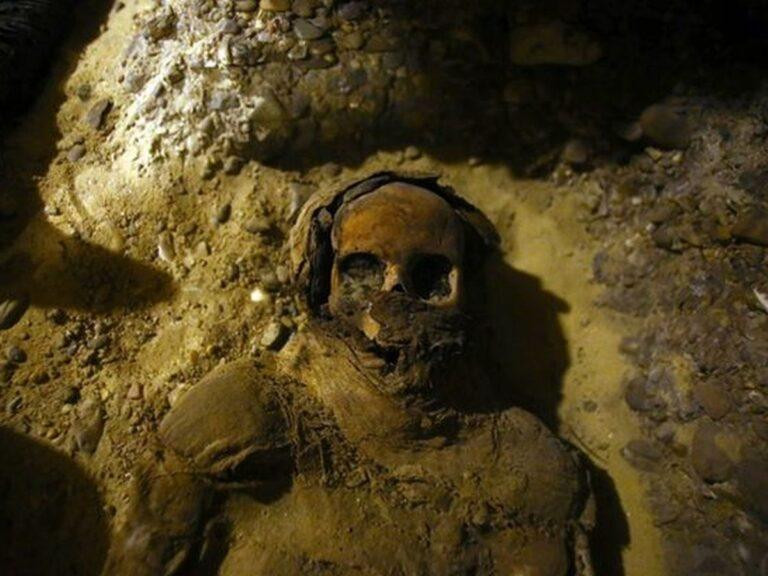In a groundbreaking archaeological find, a team of researchers has unearthed a remarkable 4,000-year-old tomb in Egypt’s arid desert. The discovery was made by a Spanish expedition led by Martina, who was investigating the reign of Hatshepsut, Egypt’s first female pharaoh. The team stumbled upon an unopened tomb tucked away in the rugged cliffs, a moment captured and documented by Channel 4’s series, “Secrets of Egypt’s Valley of the Kings.” The excavation process was painstaking and meticulous, with experts carefully working to unveil the secrets of the tomb despite facing daunting environmental challenges.
Battling the Elements
The discovery was not without its difficulties, as the harsh desert conditions posed a significant obstacle. Martina and her team had to contend with a fierce Saharan sandstorm, making the already treacherous journey to the burial site even more perilous. The narrator of the documentary vividly described the scene: “Martina’s found a coffin that’s remained sealed for nearly 4,000 years. But first, she has to get to the tomb – a Saharan sandstorm is blowing in from the south. The initial 200-meter journey to the burial site is a battle.” Despite the unforgiving winds and shifting sands, the team pressed forward with unwavering determination, motivated by the promise of uncovering new insights into ancient Egyptian civilization.

Unveiling the Ancient Coffin
After reaching the tomb, the team began the delicate process of uncovering and opening the coffin, an endeavor that required precision and care. As they removed the lid of the terracotta coffin, the anticipation was palpable. Martina’s reaction captured the intensity of the moment: “It’s very heavy, but be careful, it looks very scary. It’s like a scary movie, if this mummy is moving. I’m going as fast as I can.” The coffin, sealed for nearly four millennia, concealed an astonishing revelation waiting to be uncovered.
An Unexpected Discovery
Contrary to their expectations, the coffin did not contain a traditional mummy. Instead, the team discovered a skeleton wrapped in black material, a detail that immediately piqued their curiosity. The narrator explained, “The terracotta coffin contains no mummy but a skeleton shrouded in black material. They hope to find out why this person was interred and how they prepared for the afterlife.” This unexpected finding set the stage for a deeper investigation into the identity of the individual and the burial practices of ancient Egypt.
Unraveling the Identity
The remains were carefully examined, and as the bandages were removed, Dr. Botella revealed a critical piece of information to the team: the skeleton belonged to a woman. “I’m sure it’s a woman. The age, no more than 70,” she stated. This revelation came as a surprise, given the demographic realities of ancient Egypt. High infant mortality rates, rampant infections, and the physical toll of daily life meant that few individuals reached advanced ages. The average life expectancy during that time was significantly lower, making this discovery even more extraordinary.
Defying the Odds
The age of the skeleton defied common expectations for the time period. Dr. Bardonova elaborated on this in 2019, noting, “The average life expectancy was about 25, but far more women died during childbirth. When you have someone who is over 70, I don’t want to say I’m surprised, but it’s nice to know, it’s nice to get someone who is really old.” This ancient woman’s longevity contrasted sharply with the short lives of many of her contemporaries, including well-known figures like Tutankhamun, who is believed to have lived only to the age of 18. Her extended lifespan suggests she overcame significant challenges and lived a life that was remarkable in its own right.
The Significance of the Discovery
The discovery of this tomb and the insights it provides into the life of this ancient woman are invaluable for understanding the societal and cultural context of the time. Her advanced age indicates that she may have held a unique status or benefited from circumstances that allowed her to avoid many of the common risks that plagued others in her community. This could include access to better nutrition, a relatively safe living environment, or even a role within a social class that afforded her certain protections.
Furthermore, the presence of black material shrouding the skeleton raises intriguing questions about burial customs and beliefs surrounding the afterlife. Was this a standard practice for someone of her status, or does it signify something unique about her identity or her preparation for the journey to the afterlife? These questions will require further analysis, but they underscore the depth of information that can be gleaned from even a single archaeological discovery.
A Window into the Past
The significance of this find extends beyond the individual woman herself. It serves as a window into the broader context of ancient Egyptian life, shedding light on the social structures, health conditions, and burial practices of the time. It also highlights the resilience and determination of those who lived during this period, as well as the enduring legacy of their civilization.
As experts continue to study the remains and the artifacts found within the tomb, they hope to uncover more details about the life of this extraordinary woman and the world she inhabited. Each piece of information adds to the rich tapestry of Egypt’s history, offering a clearer picture of a civilization that continues to captivate and inspire people around the globe.
The discovery of the 4,000-year-old tomb in Egypt is a testament to the power of archaeology to unearth stories from the past that resonate with the present. Through the dedicated efforts of Martina and her team, a remarkable chapter of ancient Egyptian history has been brought to light. This woman, who defied the odds to live a long life in an era marked by hardships, reminds us of the resilience of the human spirit and the enduring quest for understanding the mysteries of our past.





